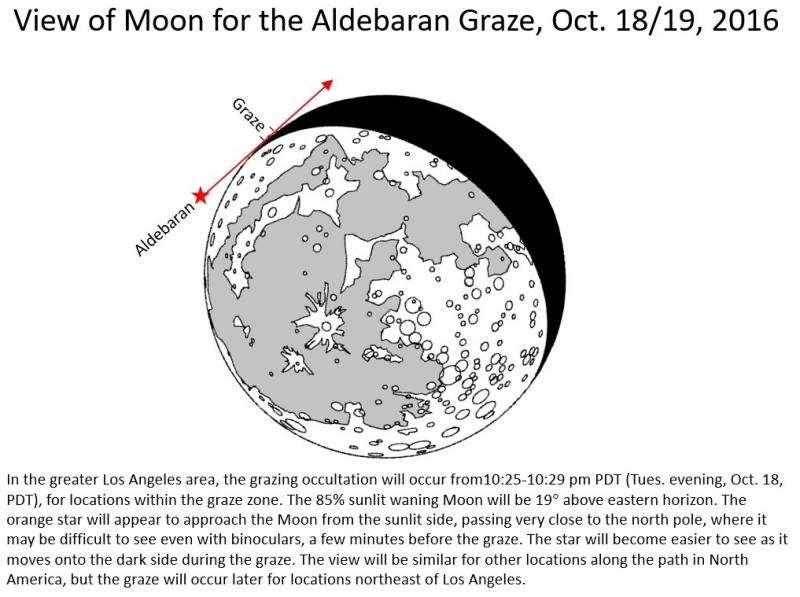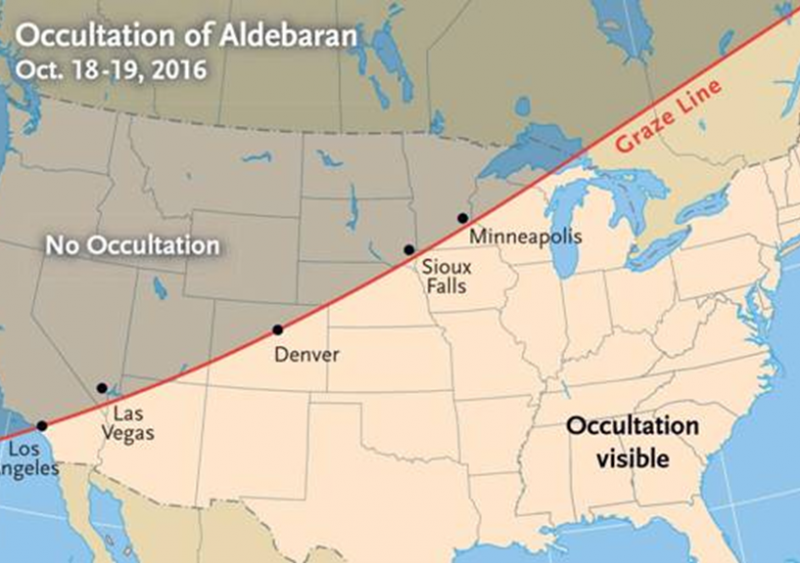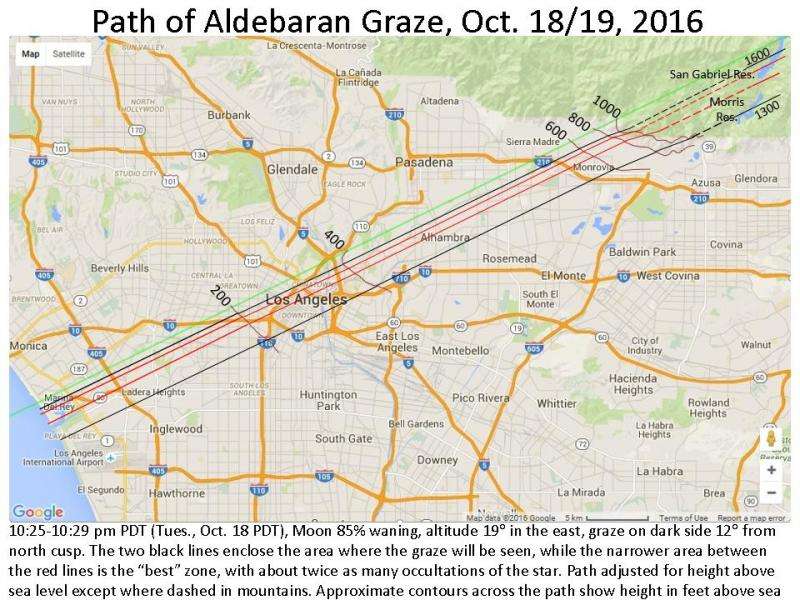Unusual lunar-grazing Aldebaran eclipse visible Tuesday, October 18 across US

As seen from a path about a mile wide extending from Los Angeles, California, to Denver, Colorado, and on to Minnesota south of Minneapolis (and further east, to Lake Superior and Labrador), the bright star Aldebaran's angular diameter will be evident to anyone using binoculars or a small telescope (weather permitting) as the star rapidly fades in and out multiple times among mountains near the moon's north pole. The fades can last even over a second to cover the star's disk, which subtends 120 feet at the moon's distance, as it is repeatedly covered and uncovered by the craggy lunar edge. In some cases, the star will fade, but not completely disappear, then reappear to full brilliance as a small hill covers only part of the star. Similarly, "faint flashes" can be seen as a shallow lunar valley drifts by. Aldebaran is the 13th brightest star in the sky (not counting the sun) and is the brightest star that is eclipsed (astronomers use the term "occulted") by the moon. A small-scale plot of the path is shown on the map that was produced by Sky & Telescope magazine using data that I supplied; an article about the graze is on page 48 of the October issue of that magazine.
The moon, rising in the east, will be waning gibbous. Aldebaran, an orange giant star 67 light-years away, will appear to approach the moon from the sunlit side, passing very close to the northern cusp a few minutes before this grazing eclipse (astronomers call it a "grazing occultation," or "graze" for short); a small telescope will be better for seeing it then. The star will become easier to see with steadily held binoculars (such as, propped against a post or wall), as it moves onto the dark side of the moon during the graze, which will last less than 3 minutes in the narrow path that is called the "graze zone."
The motion of the shadow is from west to east, so in the USA, the graze will be seen first from the Los Angeles area at 10:27 pm PDT Oct. 18 (5:27 Oct. 19 Universal Time, the central time of the 3-minute graze); at 10:29 pm PDT (5:29 Universal Time, or UT = Greenwich Mean Time) near Searchlight, NV (south of Las Vegas); at 11:40 MDT (5:40 UT) over parts of Denver; at 12:51 am CDT Oct. 19 (5:51 UT Oct. 19) south of Sioux Falls, South Dakota; and at 12:57 am CDT (5:57 UT) south of Minneapolis. The times of central graze, and other event information, are given for several cities and towns on or near the graze path near the bottom of IOTA's web page about the event. Also there are dozens of maps showing the graze zone over cities and towns near the path. Included are links to interactive Google maps where you can zoom in on the path in any desired detail anywhere along the path from Los Angeles to Labrador. Ignore the green line, which is the northern limit of the occultation computed with the assumption of a spherical moon with its average radius; since this graze occurs in a shallow part of the moon, Aldebaran will not be covered at all at the green line.
Another grazing occultation of Aldebaran was very successfully observed from Texas and Oklahoma on July 29th; results of that event, with links to some of the spectacular videos, are at www.asteroidoccultation.com/ob … ranGraze_29July2016/ . Looking at those videos will give you an idea of what to expect during the graze on October 18/19, although the moon will be much brighter this time.

Thanks to the Japanese Kaguya and NASA's Lunar Reconnaissance Orbiter (LRO) spacecraft orbiting the moon, we now have a very accurate digital model of the lunar polar regions that allows us to predict the location of the graze zone on the Earth's surface to an accuracy of about 100 feet. This Aldebaran graze is good enough to provide a unique opportunity—with enough video recordings from different places, and the star's sizable angular diameter, it may be possible to record the whole lunar profile in great detail. The observations may allow us to check the Kaguya and LRO predictions to unprecedented accuracy.
For those who live south of the graze line, and can't travel to it, a total occultation of the star will occur. There, the single reappearance of the star on the dark side of the moon should be easily seen with binoculars, if the sky is clear around the moon. The disappearance on the bright side will be harder to see; a telescope will be needed for that. The universal times of both events are given for over 1,000 cities at www.lunar-occultations.com/iot … /bstar/1019zc692.htm
This is one of the better Aldebaran grazes of the current 5-year series for North America. There are three other night-time dark-limb grazes of the star remaining for our continent:
2017 March 5 UT (evening of 4th local time), with the northern limit passing near Seattle, Duluth, Toronto, and Hartford. The moon will be 46 percent sunlit, essentially first quarter. The graze will occur at the northern cusp near Seattle, then will increase to 4 deg. on the dark side in Connecticut and south Rhode Island. Bitter cold weather could hamper observation along this rather far north winter path.

2017 Aug. 16 UT (that am), will only be visible from St. Augustine, Florida, essentially right at moonrise; very good atmospheric transparency will be needed to observe it. The moon will be 36 percent sunlit with graze 5 deg. from the north cusp on the dark side.
2018 July 10 UT (that am), the southern limit starts at moonrise in northeast Iowa, then crosses s. Wisconsin, north Michigan, and south Ontario, where twilight becomes strong. The graze will occur right at the thin southern cusp of the 11 percent sunlit waning moon.
IOTA plans to record the October 18th/19th graze from several sites in California beside Highway 39 near the San Gabriel Reservoir, and from Apple Valley, depending on weather forecasts the next few days.
Provided by IOTA




















